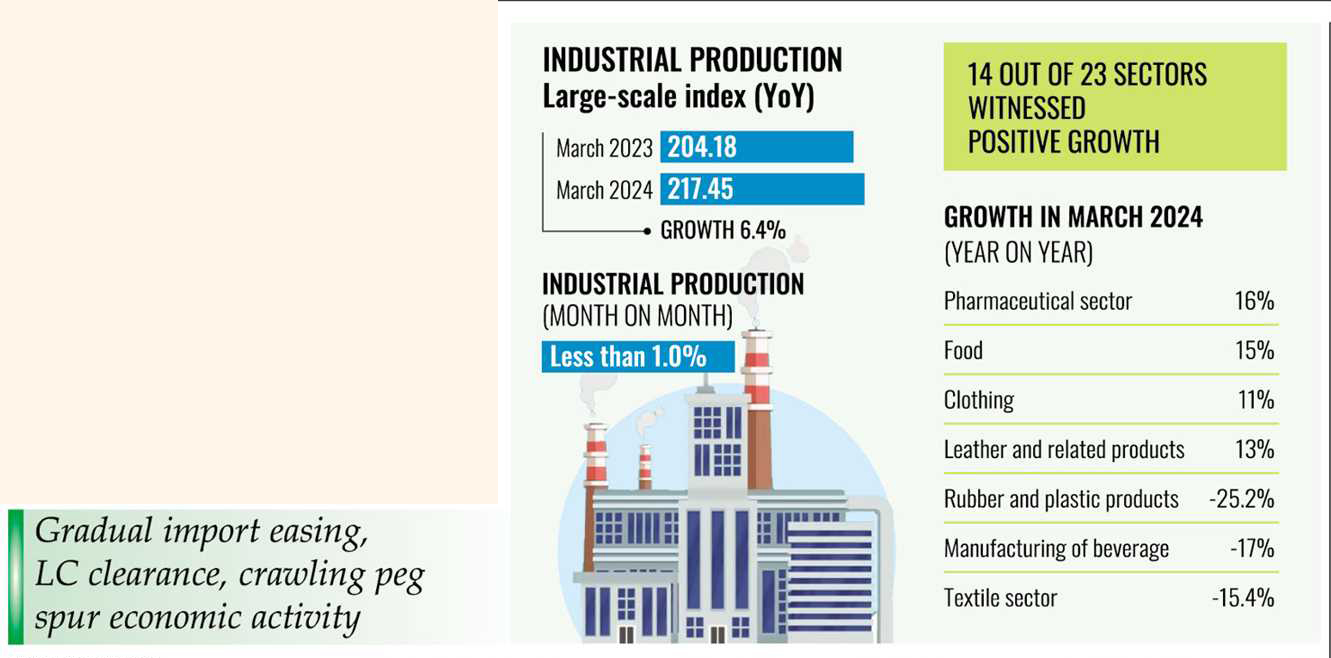
Large-scale industry throughput marks slow pickup
JASIM UDDIN HAROON | Sunday, 7 July 2024
Throughput in large-scale manufacturing industries edges up, with a 6.4-percent growth measured in March, in signs of a modest pickup in economic activity.
Such slow start of a rebound is reflected in the data released by the Bangladesh Bureau of Statistics or BBS recently. It shows industrial production in large-scale index was 217.45 in March compared to 204.18 in the same month a year earlier.
However, the index for the month marked an increase of less than 1.0 per cent over its preceding month of February 2024.
The gradual easing of import restrictions, clearance of a backlog of letters of credit and the introducing of crawling-peg system in interest-rate regime are considered spurs behind the pickup in economic activity.

During March 2024, 14 out of 23 sectors witnessed positive growth, including food, beverages, wearing apparel, leather, printing, coke and refined petroleum products, chemicals, pharmaceuticals, manufacturing of basic metal and machinery and equipment.
A large-scale focus is on the main industrial sectors and not on total GDP, but many consider the shift a proxy of the gross domestic product (GDP) concept as the prime gauge of economic advances.
Despite the prevailing domestic downside risks for the industrial sector, such as higher inflation, high input cost and high policy rate, the large industry recorded above the potential level as the global economy is expected to have a slight growth, many believe.
A slight acceleration is expected for advanced economies -- where growth is expected to rise from 1.6 per cent in 2023 to 1.7 per cent in 2024 and 1.8 per cent in 2025, according to an IMF projection on real GDP.
It notes a modest slowdown in emerging markets and developing economies -- from 4.3 per cent in 2023 to 4.2 per cent in both 2024 and 2025.
And such real GDP for low-income developing countries is projected at 4.7 per cent in 2024 and 5.2 per cent in 2025, the IMF Outlook on economy shows.
The Fund expected this positive trend to continue in remaining months of the immediate-past fiscal year.
In the pharmaceutical sector positive growth was recorded by more than 16 per cent, food by 15 per cent, clothing nearly 11 per cent and leather and related products by more than 13 per cent in March from a year ago.
Rubber and plastic products sector posted a negative growth of 25.2 per cent while manufacturing of beverage by approximately 17 per cent. The textile sector also dropped by 15.4 per cent in March over the same month last year.
Syed Nazrul Islam, first vice-president of BGMEA and managing director of Well Designers, told this correspondent that the overall orders from foreign garment buyers remained poor.
This poor demand is because of prolonged inflation in the Western economies, he says about the country's main export-earning industry.
Anwar-Ul Alam Chowdhury Pervez, a former president of the BGMEA or Bangladesh Garment Manufactures and Exporters Association, says buy orders on an average are 30 per cent less than expectation.
Aameir Alihussain, managing director of the country's biggest rod producer, BSRM, said that the overall construction activity remained poor on the grounds of higher inflation and input costs because of dollar crunch.
Mr Aameir said that money market also remained poor as a result of tight monetary policy.
jasimharoon@yahoo.com